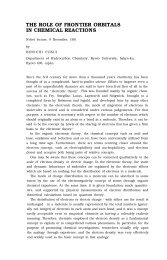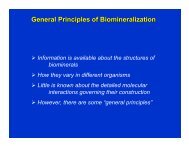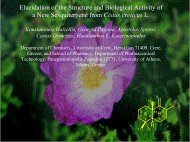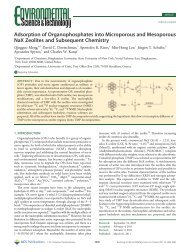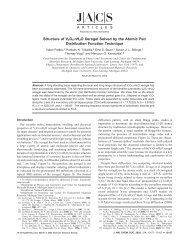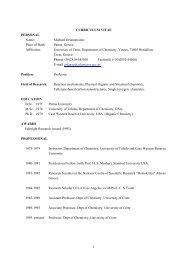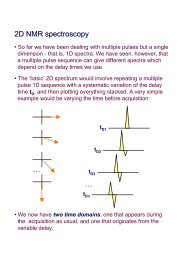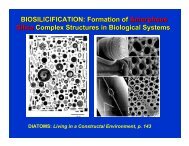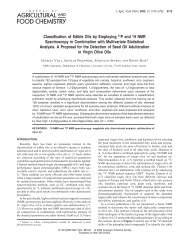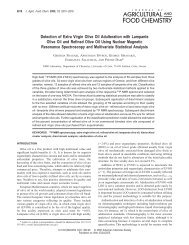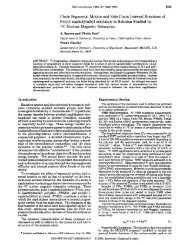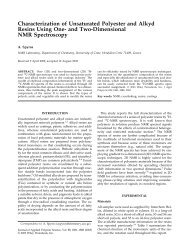Angew. Chem. Int. Ed - Department of Chemistry
Angew. Chem. Int. Ed - Department of Chemistry
Angew. Chem. Int. Ed - Department of Chemistry
Create successful ePaper yourself
Turn your PDF publications into a flip-book with our unique Google optimized e-Paper software.
COMMUNICATIONS<br />
Supramolecular Assembly <strong>of</strong> Hexagonal<br />
Mesostructured Germanium Sulfide and<br />
Selenide Nanocomposites Incorporating the<br />
Biologically Relevant Fe 4 S 4 Cluster**<br />
Pantelis N. Trikalitis, Thomas Bakas,<br />
Vasilios Papaefthymiou, and Mercouri G. Kanatzidis*<br />
The design and construction <strong>of</strong> open-framework materials<br />
with mesoscale characteristics 20 ± 200 Š) has been pr<strong>of</strong>oundly<br />
influenced by the use <strong>of</strong> organized surfactant<br />
assemblies as templating media. [1] Whereas the overwhelming<br />
majority <strong>of</strong> systems are oxides, only a few reports exist that<br />
describe nonoxidic mesostructured nanocomposites [2±4] which<br />
are now attracting great interest. [5±7] Recently, we [3, 8] and<br />
others [4, 9] demonstrated that nonoxidic mesostructured networks<br />
form by the binding <strong>of</strong> divalent metal ions with<br />
tetrahedral [Ge 4 Q 10 ] 4 Q ˆ S, Se) clusters in the presence <strong>of</strong><br />
appropriate surfactants. These clusters see Scheme 1) bind<br />
Scheme 1.<br />
metal ions in tetrahedral arrangements that can give rise to<br />
diamondoid frameworks. On the other hand the functional<br />
implications <strong>of</strong> solid-state materials with biological attributes<br />
are not yet explored, but they are many and far-reaching. In<br />
this context the introduction <strong>of</strong> metallo-bioinorganic active<br />
sites to nonbiological inorganic matrices has not been<br />
previously described. Fe/S clusters are exceptional and<br />
ubiquitous in biological systems as they provide a major part<br />
<strong>of</strong> the foundation for electron transfer, catalytic, and enzymatic<br />
processes in living organisms. [10, 11] These clusters are<br />
some <strong>of</strong> the most studied entities in chemistry and biology.<br />
They can be readily synthesized as pure discrete species in<br />
[12, 13]<br />
high yield. Many proteins such as ferredoxins and<br />
hydrogenases contain Fe/S clusters and exploit their redox<br />
properties. Arguably, the cubane geometry is the most<br />
pervasive structural arrangement in biological cluster chemistry,<br />
and consists <strong>of</strong> a core <strong>of</strong> four iron and four sulfur atoms<br />
[*] Pr<strong>of</strong>. M. G. Kanatzidis, Dr. P. N. Trikalitis<br />
<strong>Department</strong> <strong>of</strong> <strong>Chem</strong>istry, Michigan State University<br />
East Lansing, MI 48824-1322 USA)<br />
Fax: ‡ 1) 517-353-1793<br />
E-mail: kanatzid@cem.msu.edu<br />
Dr. T. Bakas, Pr<strong>of</strong>. V. Papaefthymiou<br />
<strong>Department</strong> <strong>of</strong> Physics<br />
University <strong>of</strong> Ioannina Greece)<br />
[**] Financial support from the National Science Foundation CHE 99-<br />
03706, <strong>Chem</strong>istry Research Group) is gratefully acknowledged. Part<br />
<strong>of</strong> this work was carried out using the facilities <strong>of</strong> the Center for<br />
Electron Optics <strong>of</strong> Michigan State University.<br />
distributed over alternating vertices <strong>of</strong> a cube see Scheme 1).<br />
Thus, it would be interesting to incorporate it as a functional<br />
unit into materials.<br />
Here we report a rational approach, using the supramolecular<br />
assembly <strong>of</strong> adamantane [Ge 4 Q 10 ] 4 Q ˆ S, Se)<br />
clusters with substitutionally labile [Fe 4 S 4 Cl 4 ] 2 clusters templated<br />
by cationic surfactant molecules to produce novel<br />
hexagonal mesophases built with the biologically relevant<br />
[Fe 4 S 4 ] core Fe4S4-MSU-1 for [Ge 4 S 10 ] 4 ) and Fe4S4-MSU-<br />
2 for [Ge 4 Se 10 ] 4 ). The preferred coordination geometry <strong>of</strong> the<br />
[Fe 4 S 4 ] core is tetrahedral and is well suited to form threedimensional<br />
frameworks when combined with other linking<br />
anions which also prefer tetrahedral binding, for example the<br />
[Ge 4 Q 10 ] 4 Q ˆ S, Se) clusters. These structures have parallel<br />
pore tunnels with separations <strong>of</strong> 35 Š and could provide the<br />
architectural and conceptual framework for exploring and<br />
understanding a new class <strong>of</strong> materials at the interface <strong>of</strong><br />
materials science and bioinorganic chemistry. The inclusion <strong>of</strong><br />
well-studied protein active sites in extended solid-state<br />
frameworks represents an important step towards achieving<br />
useful and functional interfaces between biological and<br />
materials chemistry.<br />
Supramolecular assembly <strong>of</strong> adamantane [Ge 4 S 10 ] 4 and<br />
[Ge 4 Se 10 ] 4 clusters, in a nonaqueous medium, with substitutionally<br />
labile [Fe 4 S 4 Cl 4 ] 2 clusters [14, 15] in the presence <strong>of</strong> a<br />
cationic surfactant resulted in the formation <strong>of</strong> novel mesophases<br />
containing [Fe 4 S 4 ] 2‡ cores. Metathesis reactions between<br />
[Ge 4 S 10 ] 4 or [Ge 4 Se 10 ] 4 and [Fe 4 S 4 Cl 4 ] 2 in the<br />
presence <strong>of</strong> cetylpyridinium CP) bromide, in formamide/<br />
dimethylformamide DMF) mixtures gave ordered hexagonal<br />
mesostructured CP-[Fe 4 S 4 ]/Ge 4 S 10 ) and CP-[Fe 4 S 4 ]/Ge 4 Se 10 )<br />
materials. These materials, referred to as Fe4S4-MSU-1 and<br />
Fe4S4-MSU-2, respectively, are dark brown and have a<br />
reproducible and consistent composition. The samples were<br />
analyzed with energy-dispersive spectroscopy EDS) in a<br />
scanning electron microscope and showed only Fe, S, Ge, and<br />
Se Figure 1 a). Combined with C, H, N analyses we obtain the<br />
empirical formulae CP) 3 Fe 4 S 4 Ge 4 S 10‡d for Fe4S4-MSU-1 and<br />
CP) 3.4 Fe 4 S 4 Ge 4 Se 10‡d for Fe4S4-MSU-2. [16]<br />
The mesostructured nature <strong>of</strong> Fe4S4-MSU-1 and Fe4S4-<br />
MSU-2 is evident in the powder X-ray diffraction patterns<br />
that show strong diffraction peaks at very low scattering<br />
angles Figure 1 b). These are analogous to those <strong>of</strong> the<br />
hexagonal mesoporous silica phases. [17] We index the three<br />
reflections for Fe4S4-MSU-1 at 34.2, 19.5, and 17.3 Š as 100),<br />
110), and 200), respectively, with a hexagonal lattice<br />
parameter <strong>of</strong> a H ˆ 39.5 Š. The corresponding values for<br />
Fe4S4-MSU-2 are 34.9, 20.6, and 18.5 Š with a H ˆ 40.3 Š.<br />
As with the conventional mesostructured oxides, [18] we do not<br />
observe Bragg diffraction peaks at wide angles, suggesting<br />
that the inorganic walls <strong>of</strong> Fe4S4-MSU-1 and Fe4S4-MSU-2<br />
lack long-range order. Nevertheless, these materials exhibit<br />
well-defined diffuse scattering at 2q > 108 consistent with the<br />
presence <strong>of</strong> short-range local order in the wall structure.<br />
Thermal gravimetric analyses TGA) <strong>of</strong> Fe4S4-MSU-X<br />
materials show that they lose all their surfactant molecules<br />
between 200 and 500 8C Figure 1 c). The first weight loss step<br />
occurs at 250 8C which corresponds to the removal <strong>of</strong> the<br />
pyridine head group identified by mass spectrometry). This is<br />
4558 WILEY-VCH Verlag GmbH, D-69451 Weinheim, 2000 1433-7851/00/3924-4558 $ 17.50+.50/0 <strong>Angew</strong>. <strong>Chem</strong>. <strong>Int</strong>. <strong>Ed</strong>. 2000, 39, No.24
COMMUNICATIONS<br />
Figure 1. a) Typical energy-dispersive X-ray fluorescence spectrum showing the presence <strong>of</strong> C, N, Fe, Ge, and S elements in Fe4S4-MSU-1. The absence <strong>of</strong><br />
elements associated with the counterions <strong>of</strong> the starting reagents e. g. Br, Cl, and P <strong>of</strong> Ph 4 P ‡ ) is evident. b) X-ray scattering Cu Ka radiation) from Fe4S4-<br />
MSU-1 top) and Fe4S4-MSU-2 bottom). Peaks are indexed to a hexagonal cell. I ˆ intensity. c) Corresponding thermal gravimetric analysis TGA) data.<br />
Experiments were performed under nitrogen flow with a heating rate <strong>of</strong> 10 deg min 1 .<br />
followed by a second step from 250 to 500 8C, which is<br />
associated with the loss <strong>of</strong> the long hydrocarbon chain. The<br />
weight loss values are in good agreement with the elemental<br />
C, H, N analyses. At 500 8C the materials decompose to<br />
amorphous GeS 2 and FeS x .<br />
High-resolution transmission electron micrographs<br />
HRTEM) <strong>of</strong> Fe4S4-MSU-1 and Fe4S4-MSU-2 reveal a<br />
strikingly regular hexagonal organization <strong>of</strong><br />
the inorganic framework pores Figure 2),<br />
which resemble those obtained for hexagonal<br />
mesoporous oxides MCM-41) [17] and cetyltrimethylammonium<br />
CTA)/M 2 Ge 4 S 10 . [9] Overall,<br />
the samples appear homogeneous. The dimensions<br />
<strong>of</strong> the channels and the presence <strong>of</strong><br />
hexagonal order are consistent with the X-ray<br />
diffraction results. The width <strong>of</strong> the channels in<br />
Figure 2 is roughly 24 ± 26 Š. The hexagonal<br />
domains are very large > 400 nm) in both<br />
Fe4S4-MSU-1/2 and <strong>of</strong>ten span the length <strong>of</strong><br />
entire particles.<br />
The existence <strong>of</strong> the [Fe 4 S 4 ] core in these<br />
mesostructures was confirmed with Mössbauer<br />
spectroscopy. The Mössbauer spectrum <strong>of</strong><br />
Fe4S4-MSU-1 at 85 K Figure 3 a) shows two<br />
closely spaced quadrupole doublets equal<br />
areas) with an isomer shift d <strong>of</strong> 0.47and 0.45 mm s 1<br />
and a quadrupole splitting DE q <strong>of</strong> 1.14 and 0.84 mm s 1 ,<br />
respectively. The parameters for Fe4S4-MSU-2 are d ˆ 0.50/<br />
0.47mm s 1 and DE q ˆ 0.66/1.14 mm s 1 , respectively. These<br />
are typical values for [Fe 4 S 4 ] 2‡ cores in asymmetric environments<br />
both in ferredoxins and synthetic model<br />
[19, 20]<br />
com-<br />
[21, 22]<br />
pounds.<br />
Figure 2. TEM images <strong>of</strong> Fe4S4-MSU-1; view down the tunnels left; [001] direction) and<br />
view perpendicular to the tunnel axis right; [100] direction), showing the parallel<br />
organization and straight character <strong>of</strong> the tunnels. TEM samples were prepared by<br />
suspending the precipitate in diethyl ether, then casting on a holey carbon grid. Highresolution<br />
transmission electron micrographs were acquired with a JEOL 120CX instrument<br />
equipped with a CeB 6 filament.<br />
<strong>Angew</strong>. <strong>Chem</strong>. <strong>Int</strong>. <strong>Ed</strong>. 2000, 39, No. 24 WILEY-VCH Verlag GmbH, D-69451 Weinheim, 2000 1433-7851/00/3924-4559 $ 17.50+.50/0 4559
COMMUNICATIONS<br />
Figure 3. a) 57 Fe Mössbauer spectra <strong>of</strong> Fe4S4-MSU-1 top) and Fe4S4-MSU-2 bottom) at 85 K. The solid lines are least-squares fits for the d and DE q<br />
parameters quoted in the text. rel. trans. ˆ relative transmission. b) Infrared spectra <strong>of</strong> Fe4S4-MSU-1 top), Ph 4 P) 2 Fe 4 S 4 Cl 4 center; the strong peak at<br />
528 cm 1 is from the Ph 4 P ‡ cation), and Me 4 N) 4 Ge 4 S 10 bottom). The spectra were taken as pressed CsI pellets. T ˆ transmittance. c) UV/Vis spectrum in<br />
DMF <strong>of</strong> the [Fe 4 S 4 SPh) 4 ] 2 cluster extracted from Fe4S4-MSU-1 and Fe4S4-MSU-2 upon reaction with excess PhS or PhSH showing the characteristic l max<br />
at 445 nm 13, 20). A ˆ absorbance. d) Typical electronic absorption spectra <strong>of</strong> Fe4S4-MSU-1 and Fe4S4-MSU-2. E ˆ energy.<br />
The far-IR spectrum <strong>of</strong> Fe4S4-MSU-1 shows characteristic<br />
bands at 467m), 423 m,sh), 405 vs), 355 s), 330 m), 308<br />
m), and 199m) cm 1 , respectively Figure 3 b). Those at 467,<br />
423, 405, 330, and 199 cm 1 correspond to the modes <strong>of</strong> the<br />
adamantane [Ge 4 S 10 ] 4 cluster, whereas those at 355 and<br />
308 cm 1 are due to the internal modes <strong>of</strong> the Fe 4 S 4 cluster.<br />
The terminal Ge S stretching modes in the free [Ge 4 S 10 ] 4<br />
occurring at 457and 344 cm 1 Figure 3 b top) shift to lower<br />
frequencies at 423 and 330 cm 1 in Fe4S4-MSU-1 due to Fe<br />
ligation. The strong peak at 396 cm 1 in the free [Ge 4 S 10 ] 4 is<br />
due to modes internal to the Ge 4 S 6 core and is not significantly<br />
affected; it occurs at 405 cm 1 in Fe4S4-MSU-1. Fe4S4-MSU-<br />
2 shows bands at 386 m), 352 vs), 321 m, sh), 307vs), 284<br />
s), 255 w), 227w), and 202 w) cm 1 , respectively. The<br />
bands at 321, 284, originate from the [Ge 4 Se 10 ] 4 cluster, [23]<br />
whereas those at 352 and 307cm 1 are due to Fe 4 S 4 cluster.<br />
The presence <strong>of</strong> Fe 4 S 4 clusters in these materials was<br />
independently determined by the excision method used to<br />
identify them in proteins. [24, 25] This involves cluster extraction<br />
from the protein by ligand exchange with excess thiol e.g.<br />
PhSH). When Fe4S4-MSU-1 and Fe4S4-MSU-2 were treated<br />
with excess PhSH or PhS ; 4 ± 8 equiv) in DMF they<br />
dissolved promptly, indicating ligation and subsequent excision<br />
<strong>of</strong> the [Fe 4 S 4 ] 2‡ core from the framework according to<br />
4560 WILEY-VCH Verlag GmbH, D-69451 Weinheim, 2000 1433-7851/00/3924-4560 $ 17.50+.50/0 <strong>Angew</strong>. <strong>Chem</strong>. <strong>Int</strong>. <strong>Ed</strong>. 2000, 39, No.24
COMMUNICATIONS<br />
Equation 1). The brown solution obtained displayed a UV/<br />
Vis spectrum with an absorption maximum at 445 nm Figure<br />
3 c). This is characteristic <strong>of</strong> the presence <strong>of</strong> the molecular<br />
[Fe 4 S 4 SPh) 4 ] 2 cluster. [15, 26] The latter species was also<br />
identified by its NMR spectrum from the characteristic<br />
ortho-, meta-, and para-H resonances <strong>of</strong> the SPh ligands<br />
which occur at d ˆ 5.84, 8.25, and 5.15, respectively. [27]<br />
C 16 H 33 Py)/Fe 4 S 4 )/Ge 4 Q 10 ) ‡ 4 KSPh !<br />
[Fe 4 S 4 SPh) 4 ] 2 ‡ C 16 H 33 Py ‡ ‡ 4K ‡ ‡ [Ge 4 Q 10 ] 4 1)<br />
The optical absorption properties <strong>of</strong> these materials suggest<br />
that they are medium band-gap semiconductors. The electronic<br />
spectra show clearly defined energy gaps at 1.3 eV for<br />
both Fe4S4-MSU-1 and Fe4S4-MSU-2 see Figure 3 d). These<br />
gaps are in the same range as those <strong>of</strong> many important<br />
semiconductors such as GaAs 1.54 eV) and CdTe 1.45 eV).<br />
The construction <strong>of</strong> mesostructured chalcogenide phases<br />
that embody the biological Fe 4 S 4 center has been demonstrated<br />
by using a templated assembly process. Based on the<br />
above results we surmise that the inorganic frameworks<br />
Figure 4) <strong>of</strong> Fe4S4-MSU-1 and Fe4S4-MSU-2 resemble those<br />
functionality. Particularly intriguing, for example, would be<br />
materials incorporating the MoFe 7 S 9 -c<strong>of</strong>actor [29] <strong>of</strong> nitrogenase,<br />
an important nitrogen-fixing enzyme, that may be<br />
rendered capable <strong>of</strong> similar activity.<br />
Experimental Section<br />
57<br />
Methods: Fe Mössbauer spectra were obtained at 85 K. A constant<br />
acceleration spectrometer was used to move a 57 Co Rh) source kept at<br />
300 K. The spectrometer was calibrated with a-Fe, and isomer shift values<br />
are given relative to a-Fe at 300 K. Optical absorption spectra were<br />
obtained at 300 K with a Shimadzu UV-3101PC double beam, double<br />
monochromator spectrophotometer equipped with an integrating sphere.<br />
For details see T. J. McCarthy, S.-P. Ngeyi, J.-H. Liao, D. DeGroot, T.<br />
Hogan, C. R. Kannewurf, M. G. Kanatzidis, <strong>Chem</strong>. Mater. 1993, 5, 331 ± 340.<br />
Typical synthetic procedure: Fe4S4-MSU-1: Cetylpyridinium bromide<br />
monohydrate 4.00 g, 10 mmol) and K 4 Ge 4 S 10 0.767 g, 1 mmol) were<br />
dissolved in formamide 20 mL) at 758C to form a colorless solution. To<br />
this Ph 4 P) 2 Fe 4 S 4 Cl 4 0.883 g, 1 mmol) dissolved in DMF 10 mL) was<br />
added dropwise under stirring over a period <strong>of</strong> 2 min. The deep brown<br />
precipitate formed immediately and was aged for 24 h. It was then filtered,<br />
washed with warm water, and dried under vacuum. Approximately 1.5 g <strong>of</strong><br />
product was obtained yield > 80 % based on K 4 Ge 4 S 10 ). The procedure is<br />
similar in the case <strong>of</strong> Fe4S4-MSU.<br />
Received: September 4, 2000 [Z 15759]<br />
Figure 4. Schematic representation <strong>of</strong> the constituents <strong>of</strong> the hexagonal<br />
framework in which Fe 4 S 4 cores are linked with [Ge 4 Q 10 ] 4 clusters around<br />
the surfactant counterions.<br />
<strong>of</strong> MCM-41 and CTA/M 2 Ge 4 S 10 . The approach described here<br />
clearly points to a pathway for generating stable hybrid<br />
systems with combined biological and abiological characteristics.<br />
Such hybrid structures may find applications in shapeselective<br />
electro- and photocatalysis, artificial photosynthesis,<br />
and biosensors, particularly those based on enzymatic processes<br />
related to Fe 4 S 4 centers. [28] As part <strong>of</strong> a rigid framework,<br />
Fe 4 S 4 clusters are expected to be stable in more reactive<br />
oxidation states, for example [Fe 4 S 4 ] 1‡/3‡ . These states are<br />
readily found in proteins but are difficult to stabilize in<br />
molecules in solution. The combination <strong>of</strong> elegant, naturally<br />
refined catalytic sites with the robustness and diversity <strong>of</strong><br />
extended solid-state systems could engender a new class <strong>of</strong><br />
biologically inspired materials with unique or multiple<br />
[1] C. T. Kresge, M. E. Leonowicz, W. J. Roth, W. J. Vartuli, J. S. Beck,<br />
Nature 1992, 359, 710.<br />
[2] P. V. Braun, P. Osenar, S. I. Stupp, Nature 1996, 380, 325.<br />
[3] K. K. Rangan, S. J. L. Billinge, V. Petkov, J. Heising, M. G. Kanatzidis,<br />
<strong>Chem</strong>. Mater. 1999, 11, 2629.<br />
[4] M. J. MacLachlan, N. Coombs, G. A. Ozin, Nature 1999, 397, 681.<br />
[5] C. L. Bowes, G. A. Ozin, Adv. Mater. 1996, 8, 13.<br />
[6] J. B. Parise, Science 1991, 251, 293.<br />
[7] H. Ahari, R. L. Bedard, C. L. Bowes, T. Jiang, A. Lough, G. A. Ozin,<br />
S. Petrov, D. Young, Adv. Mater. 1995, 7, 375.<br />
[8] M. Wachhold, K. K. Rangan, M. F. Thorpe, S. J. L. Billinge, V. Petkov,<br />
J. Heising, M. G. Kanatzidis, J. Solid State <strong>Chem</strong>. 2000, 152, 21; K. K.<br />
Rangan, P. Trikalitis, M. G. Kanatzidis, J. Am. <strong>Chem</strong>. Soc. 2000, 122,<br />
10230.<br />
[9] M. J. MacLachlan, N. Coombs, R. L. Bedard, S. White, L. K.<br />
Thompson, G. A. Ozin, J. Am. <strong>Chem</strong>. Soc. 1999, 121, 12005.<br />
[10] H. Beinert, R. H. Holm, E. Münck, Science 1997, 277, 653.<br />
[11] H. Beinert, J. Biol. Inorg. <strong>Chem</strong>. 2000, 5, 2.<br />
[12] R. H. Holm, P. Kennepohl, E. I. Solomon, <strong>Chem</strong>. Rev. 1996, 96, 2239,<br />
and references therein.<br />
[13] M. G. Kanatzidis, N. C. Baenziger, D. Coucouvanis, A. Simopoulos, A.<br />
Kostikas, J. Am. <strong>Chem</strong>. Soc. 1984, 106, 4500.<br />
[14] R. W. Johnson, R. H. Holm, J. Am. <strong>Chem</strong>. Soc. 1978, 100, 5338.<br />
[15] D. Coucouvanis, M. G. Kanatzidis, E. Simhon, N. C. Baenziger, J. Am.<br />
<strong>Chem</strong>. Soc. 1982, 104, 1874.<br />
[16] Fe4S4-MSU-1 %): C 40.25, H 6.06, N 2.18; EDS analysis: Fe:Ge:S<br />
0.9:1:4; Fe4S4-MSU-2 %): C 33.72, H 5.51, N 1.85; EDS analysis:<br />
Fe:S:Ge:Se 0.8:0.9:1:2.5.<br />
[17] J. S. Beck, J. C. Vartuli, W. J. Roth, M. E. Leonowicz, C. T. Kresge,<br />
K.D. Schmitt, C. T.-W. Chu, D. H. Olsen, E. W. Shepard, S. B.<br />
McCullen, J. B. Higgins, J. L. Schlenker, J. Am. <strong>Chem</strong>. Soc. 1992,<br />
114, 10 834.<br />
[18] T. J. Barton, L. M. Bull, W. G. Klemperer, D. A. Loy, B. McEnaney, M.<br />
Misono, P. A. Monson, G. Pez, G. W. Scherer, J. C. Vartuli, O. M.<br />
Yaghi, <strong>Chem</strong>. Mater. 1999, 11, 2633.<br />
[19] R. Cammack, D. P. E. Dickson, C. E. Johnson in Iron ± Sulfur Proteins,<br />
Vol. III <strong>Ed</strong>.: W. Lovenberg), Academic Press, New York, 1977, p. 283.<br />
[20] W. H. Orme-Johnson, N. R. Orme-Johnson in Metal Ions in Biology,<br />
Vol. 4 <strong>Ed</strong>.: T. G. Spiro), Wiley, New York, 1982, p.67.<br />
[21] R. H. Holm, J. A. Ibers in Iron ± Sulfur Proteins, Vol. III <strong>Ed</strong>.: W.<br />
Lovenberg), Academic Press, New York, 1977, p. 206.<br />
<strong>Angew</strong>. <strong>Chem</strong>. <strong>Int</strong>. <strong>Ed</strong>. 2000, 39, No. 24 WILEY-VCH Verlag GmbH, D-69451 Weinheim, 2000 1433-7851/00/3924-4561 $ 17.50+.50/0 4561
COMMUNICATIONS<br />
[22] V. Papaefthymiou, M. M. Millar, E. Münck, Inorg. <strong>Chem</strong>. 1986, 25,<br />
3010.<br />
[23] The K 4 Ge 4 Se 10 exhibits bands at 318 vs), 282 vs), 255 s, sh), and 208<br />
w) cm 1 .<br />
[24] L. Que, R. H. Holm, L. E. Mortenson, J. Am. <strong>Chem</strong>. Soc. 1975, 97, 463.<br />
[25] W. O. Gillum, L. E. Mortenson, J.-S. Chen, R. H. Holm, J. Am. <strong>Chem</strong>.<br />
Soc. 1977, 99, 584.<br />
[26] R. B. Frankel, T. Herskovitz, B. A. Averill, R. H. Holm, P. J. Krusic,<br />
W. D. Phillips, Biochem. Biophys. Res. Commun. 1974, 58, 974.<br />
[27] R. H. Holm, W. D. Phillips, B. A. Averill, J. J. Mayerle, T. Herskovits,<br />
J. Am. <strong>Chem</strong>. Soc. 1974, 96, 2109.<br />
[28] T. A. Rouault, R. D. Klausner, Trends Biochem. Sci. 1996, 21, 174.<br />
[29] J. S. Kim, D. C. Rees, Nature 1992, 360, 553.<br />
The special steric and electronic properties <strong>of</strong> polyhedral<br />
borane and carborane clustersÐnotably their three-dimensional<br />
geometry and electron delocalization aromatic character)Ðare<br />
being employed to advantage in the construction<br />
<strong>of</strong> novel molecular architectures for use in a variety <strong>of</strong><br />
projected applications in materials synthesis, microelectronics,<br />
optics, and medicine. [1] In recent work some remarkable<br />
compound types have been produced in which boron clusters<br />
serve as scaffolds or templates for attachment <strong>of</strong> organic<br />
moieties; examples include 1,7-C 2 B 10 H 10 ) n Hg n ªanti-crownsº<br />
n ˆ 3, 4), [1d, 2] peralkylated carboranes that mimic spherical<br />
hydrocarbons, [3] and benzene-m-carboranyl macrocycles. [4]<br />
This paradigm can be reversed: Hydrocarbons may serve as<br />
frameworks for attachment <strong>of</strong> multiple boron clusters. If an<br />
aromatic system such as benzene is employed as a linchpin<br />
connecting several metallaboron units, one might prepare<br />
polynuclear, electron-delocalized, mixed-valence systems that<br />
are not only interesting from a fundamental perspective, but<br />
may also have practical potential as precursors or models for<br />
new kinds <strong>of</strong> electronically tailorable organometallic compounds.<br />
Although 1,3,5-triscarboranyl)benzene derivatives<br />
incorporating icosahedral 1,2- or 1,12-C 2 B 10 polyhedra have<br />
been reported, [5] no corresponding metallaborane or metallacarborane<br />
species i.e., having metal atoms in the polyhedral<br />
framework) have been described; to our knowledge, the<br />
closest known metal system is the dimetallic 1,4-bis-<br />
7-cobaltacarboranyl)benzene complex 1 B ˆ BH, B), which<br />
Benzene-Centered Tri- and<br />
Tetrametallacarborane Sandwich Complexes**<br />
Martin Bluhm, Hans Pritzkow, Walter Siebert,* and<br />
Russell N. Grimes*<br />
[*] Pr<strong>of</strong>. Dr. R. N. Grimes, Dr. M. Bluhm<br />
<strong>Department</strong> <strong>of</strong> <strong>Chem</strong>istry<br />
University <strong>of</strong> Virginia<br />
Charlottesville, VA 22901 USA)<br />
Fax: ‡ 1) 804-924-3710<br />
E-mail: rng@virginia.edu<br />
Pr<strong>of</strong>. Dr. W. Siebert, Dr. H. Pritzkow<br />
Anorganisch-chemisches Insititut der Universität<br />
Im Neuenheimer Feld 276<br />
69120 Heidelberg Germany)<br />
Fax: ‡ 49) 6221-54-5609<br />
E-mail: ci5@ix.urz.uni-heidelberg.de<br />
[**] Organotransition-Metal Metallacarboranes, part 56. This work was<br />
supported in part by the National Science Foundation grant CHE<br />
9980708 to R.N.G.) and the Deutsche Forschungsgemeinschaft SFB<br />
247, to W.S. for M.B.). Part 55: T. Dodge, M. A. Curtis, J. M. Russell,<br />
M. Sabat, M. G. Finn, R. N. Grimes, J. Am. <strong>Chem</strong>. Soc. 2000, 122,<br />
10 573.<br />
was recently prepared in one <strong>of</strong> our laboratories. [6] In contrast,<br />
a number <strong>of</strong> benzene-centered trinuclear organometallic<br />
compounds <strong>of</strong> the type 1,3,5-C 6 H 3 XML n ) 3 have been synthesized,<br />
[7] in which transition metals M are linked to benzene<br />
through groups X e.g. alkynyl). Here we report the designed<br />
synthesis <strong>of</strong> the first metallacarborane systems <strong>of</strong> this class.<br />
The approach utilized boron-recapping ªrecapitationº) <strong>of</strong><br />
nido-[1,2,3-Cp*Co2,3-Et 2 C 2 B 3 H 3 )] 2 Cp* ˆ C 5 Me 5 ), a method<br />
recently developed in our groups for preparing mono- or<br />
dimetallic species bearing substituents at the apex [B7)]<br />
boron atom. [6, 8] In the present work, we required a suitable<br />
trifunctional benzene derivative as a precursor to the desired<br />
metal complexes. Accordingly, 1,3,5-trisdiiodoboryl)benzene<br />
3), previously prepared but not isolated, [9] was generated<br />
from the corresponding tristrimethylsilyl)benzene as shown<br />
in Scheme 1 and isolated in 30 % yield as a colorless, air-<br />
Scheme 1. Synthesis <strong>of</strong> 3.<br />
sensitive solid. Treatment <strong>of</strong> Li 2 [Cp*Co2,3-Et 2 C 2 B 3 H 3 )] 4)<br />
with one-third molar equivalent <strong>of</strong> 3 in toluene at 0 8C gave<br />
the target compound [{Cp*Co2,3-Et 2 C 2 B 4 H 3 -7)} 3 C 6 H 3 ]5) as<br />
a moderately air-stable yellow complex in 46 % yield<br />
Scheme 2).<br />
Characterization <strong>of</strong> 5 by multinuclear NMR and IR<br />
spectroscopy as well as mass spectrometry supports the<br />
trigonally symmetric geometry shown the rotamer depicted<br />
is arbitrary), and the solid-state structure has been confirmed<br />
by X-ray crystallography Figure 1). [10] With the exception <strong>of</strong><br />
the benzene ring see the figure caption), the bond lengths<br />
and angles are normal, and the metal atoms and apical boron<br />
atoms are coplanar with the benzene ring. A notable feature<br />
<strong>of</strong> the 1 H NMR spectrum <strong>of</strong> 5 is the strong upfield shift <strong>of</strong> the<br />
aromatic benzene resonances d ˆ 5.92 in CDCl 3 versus 7.51<br />
for benzene itself), reflecting the electron-donating character<br />
<strong>of</strong> the carborane ligand for comparison, the corresponding<br />
4562 WILEY-VCH Verlag GmbH, D-69451 Weinheim, 2000 1433-7851/00/3924-4562 $ 17.50+.50/0 <strong>Angew</strong>. <strong>Chem</strong>. <strong>Int</strong>. <strong>Ed</strong>. 2000, 39, No.24




